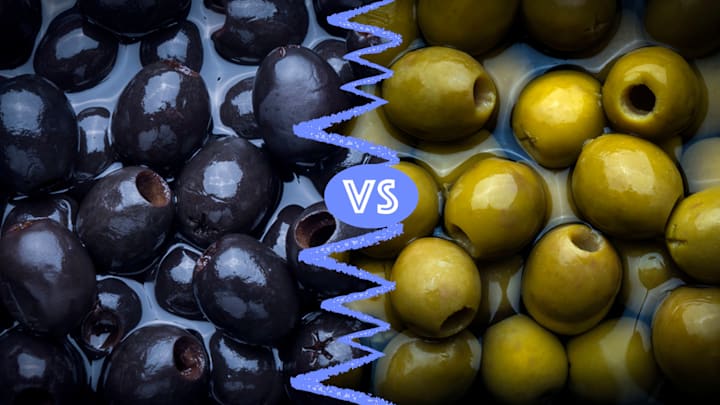There’s widespread disagreement when it comes to olives, whether they‘re black or green. But have you ever wondered if there‘s a difference between the two besides color? The annoying, yet honest, answer is yes and no.
- Are Green Olives and Black Olives the Same Thing?
- Green Olives vs. Black Olives: Similarities and Differences
- How Green and Black Olives Are Processed
Are Green Olives and Black Olives the Same Thing?

Both are essentially the same fruit: Green olives are the unripe versions of black olives. Sporked says green olives are known for being a bit more bitter than black ones. Black olives tend to be oilier and contain less salt than green ones, primarily due to their packaging differences.
Green Olives vs. Black Olives: Similarities and Differences
Black olives | Green olives | |
|---|---|---|
Origin | Olive (Olea europaea) trees | Olive (Olea europaea) trees |
Taste | Mild, buttery, oily | Salty, bitter, tangy |
When are they harvested? | When ripe | When underripe |
How are they treated? | Usually straight to salt brining | Lye soaking before salt brining |
Common uses | Pizzas, pasta salads, salads | Charcuterie boards, sandwiches, martini garnish |
How Green and Black Olives Are Processed
Whether talking about non-ripe or ripe olives, you usually won’t find a fresh version of the fruit in grocery stores; they’re always fermented or treated in some way. This is because olives contain a lot of oleuropein, a compound that makes them super bitter and unappetizing. Although studies show that oleuropein has health benefits, such as antioxidant and anti-inflammatory effects, few can tolerate the abrasive taste.
Olive producers have ways of combating the unappealing flavor. They will soak the fruits in water, ferment them in salt brine, or treat them with sodium hydroxide (a.k.a. lye) to break down the oleuropein. Lye soaking is usually the go-to process; it only takes about one week compared to the other methods, which can take several weeks. Green olives almost always soak in a lye solution before brining, whereas fully ripe black olives can head straight to the brining process.
To add another wrinkle to the matter, most black olives you find on grocery store shelves aren’t picked when ripe. They’re actually harvested green olives that have been artifically ripened using ferrous gluconate, an oxygen and iron compound that turns the fruits black. This is cheaper than waiting months for olives to ripen on the branch, but it results in a less flavorful product.
Now that you know how green olives and black olives differ, you can read about the distinction between extra virgin olive oil and the regular stuff here.
Read More “What‘s the Difference?” Articles:
